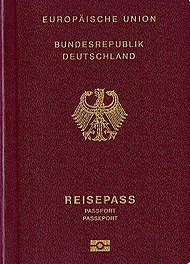
Back جواز سفر ألماني Arabic Германски паспорт Bulgarian Německý cestovní pas Czech Deutscher Reisepass German Pasaporte alemán Spanish Saksamaa pass Estonian گذرنامه آلمانی Persian Passeport allemand French Putovnica Njemačke Croatian Գերմանիայի քաղաքացու արտասահմանյան անձնագիր Armenian
| |
|---|---|
 | |
| Type | Passport |
| Issued by | |
| First issued | 12 October 1867 (first passport regulations, as North German Confederation) 1949 (first West German passport) 1988 (machine-readable passport) 1 November 2005 (biometric passport) 1 March 2017 (current version) |
| Purpose | ID |
| Eligibility | German citizenship |
| Expiration | 10 years after issuance for individuals aged 24 and above; 6 years for citizens 23 and under. |
| Cost | €70 (over 24) / €37.50 (under 24)[1] |
A German passport (German: deutscher Reisepass, pronounced [ˈdɔʏtʃɐ ˈʁaɪzəˌpas] ⓘ) is an identity document issued to nationals of Germany for the purpose of international travel. A German passport is, besides the German ID card and the German Emergency Travel Document (called "Reiseausweis als Passersatz"), the only other officially recognised document that German authorities will routinely accept as proof of identity from German citizens. Besides serving as proof of identity and presumption of German nationality, they facilitate the process of securing assistance from German consular officials abroad (or other EU members in the case that a German consular facility is absent). German passports are valid for ten years (for people over the age of 23) or six years (for people under the age of 24) and share the standardised layout and burgundy red design with other EU passports. Every German citizen is also a citizen of the European Union. The passport, along with the national identity card, allows for free rights of movement and residence in any of the states of the European Union, European Economic Area and Switzerland.
© MMXXIII Rich X Search. We shall prevail. All rights reserved. Rich X Search